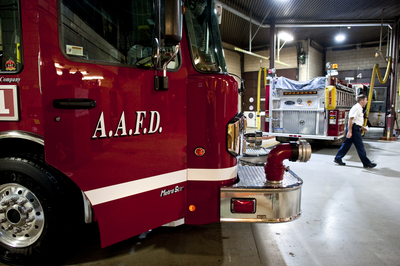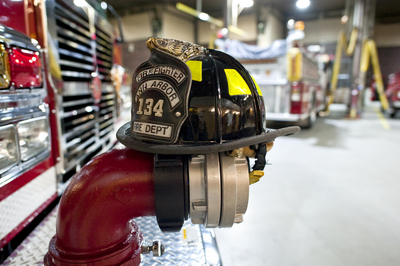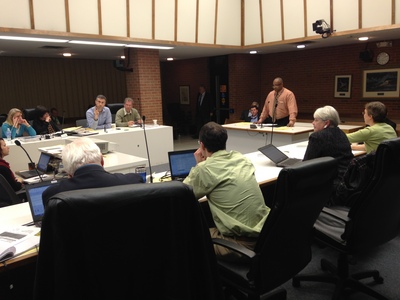Ann Arbor Mayor John Hieftje attempted to put the issue of closing city fire stations to rest Monday night after a heated discussion ensued during a City Council work session.
"I think it would be beneficial to take it off the table," Hieftje said of Fire Chief Chuck Hubbard's proposal still lingering from more than a year ago to switch from five to three stations.
"It seems very apparent that it's not going anywhere," Hieftje said of the restructuring plan that had the city administrator's support.
Clik here to view.

A proposal to close fire stations in Ann Arbor won't be going forward, Mayor John Hieftje said during a council work session Monday night.
Joseph Tobianski I AnnArbor.com
The question came up after Council Member Jane Lumm, an Independent who represents the 2nd Ward, asked Hubbard if he still thought closing fire stations and going to a three-station model was a valid option. It was listed as an option in a staff report to council Monday night.
"As far as I'm concerned, yes, it is still a valid option," Hubbard said, explaining how consolidating the fire department's limited staffing into three stations could help with fire responses by making sure each station has a minimum of four firefighters at any given time.
He believes that would get the department closer to meeting national standards that suggest four firefighters should arrive at a fire within four minutes 90 percent of the time. He also acknowledged there could be some instances where it takes an extra two or three minutes, though.
Hubbard's comments sparked a discussion among council members, most of whom indicated they're not convinced closing fire stations is the way to go. Multiple council members thanked the mayor for, as they saw it, effectively ending the idea of closing stations.
"Our community deserves that closure," Lumm said. "People just want to see us provide a high-level of fire emergency services and meet industry standards for response time."
Lumm, who wants to increase fire staffing, encouraged the fire chief to give guidance to council on how to meet community expectations without closing fire stations.
Council Member Stephen Kunselman, D-3rd Ward, passed along praises for the fire department from a resident whose dryer caught fire recently.
"He also was adamant that if that truck had to come from somewhere else other than the station on Huron Parkway (one of three the city has considered closing), their house would not have been saved," he said, stressing the importance of having stations near neighborhoods.
Council Member Marcia Higgins, D-4th Ward, noted the city still has a fire station that's been closed for several years: Station 2 at Stadium and Packard.
"I've heard repeatedly that Station 2 is an integral piece because of where it's situated, as far as providing support to every other station," she said, adding she'd be curious to know the cost of staffing Station 2.
John Seto, the city's public safety administrator, gave a report to council Monday night in which he acknowledged the city's fire staffing and deployment is not optimized to meet the National Fire Protection Association standards for fire suppression.
The fire department has 86 full-time employees, and so far there are no proposals on the table to either reduce or increase that number heading into the new fiscal year July 1.
One of the city's stated goals for the fire department is to have fire stations — both in numbers and locations — optimized to meet community needs and industry standards within resources.
Seto and Hubbard are in agreement the city needs to clarify what it means by "community needs," and whether priority should be placed on both fire suppression and medical response.
Clik here to view.

Hubbard suggested the city could reduce the daily minimum staffing needed at the city's fire stations — without closing any stations — by deploying more light rescue vehicles that can be operated by just two firefighters, whereas a typical fire truck requires a minimum of three firefighters.
Joseph Tobianski | AnnArbor.com
Seto talked about the cost of hiring additional firefighters in terms of the "five-year cost," or what each would cost after five years with built-in pay increases. The five-year cost for each additional firefighter works out to $86,912 annually, he said, plus a $10,128 one-time cost.
Hubbard suggested the city could reduce the daily minimum staffing needed at the city's fire stations — without closing any stations — by deploying more light rescue vehicles that can be operated by just two firefighters, whereas a typical fire truck requires a minimum of three firefighters.
The cost of an additional light rescue vehicle is $264,500. Deploying additional light rescue vehicles, Seto said, could reduce minimum staffing requirements without impacting medical responses.
Council Member Margie Teall, D-4th Ward, said the city has been talking about light rescue vehicles for a long time.
"I'm not sure why we haven't moved ahead in that direction, because I thought it was pretty clear a while back that was going to be a great cost saver," she said.
Hubbard said the city did go through a bid process for a light rescue vehicle last year, but after it got down to the final stage, there were issues with the chosen vendor.
"So we have to re-bid it," he said.
He said there's a request for proposals awaiting review from the city attorney's office and it should be released soon. He noted the department does have one light rescue vehicle in service already.
He said the light rescue vehicles, although they don't carry any water, come equipped with all the necessary medical equipment, extrication equipment, and they still can respond to fires because the firefighters have their tools on the truck and their gear.
On a related note, Hubbard said he's expecting delivery of a new 100-foot aerial platform truck from Ohio-based Sutphen Corp. by next month. The new $1 million fire truck, which the council voted to approve last August, will replace a 75-foot ladder truck from 1999.
"Tomorrow is the final inspection down in Dublin, Ohio," Hubbard said. "The truck has been, for the most part, completed."
Lumm switched gears Monday night and brought up the issue of fire inspections at local businesses, which Hubbard has been aggressive about since taking over as fire chief in 2011.
She suggested commercial property and business owners are questioning the extra inspection fees they're paying now and wondering if it's a revenue grab by the city.
Clik here to view.

Fire Chief Chuck Hubbard appears before the Ann Arbor City Council during a budget-related work session Monday night.
Ryan J. Stanton | AnnArbor.com
Hubbard said the fire department's ramped-up efforts to inspect several hundred businesses annually is part of a new proactive approach to fire safety.
"That is what it's designed around," he said. "In our past history, we have not been very diligent in that area. I can't speak to why because I was not in this position at the time."
A line item labeled "charges for services" in the fire department's roughly $14 million budget was projected to bring in $742,476 in revenue this fiscal year. That's about five times the amount of revenue the department used to collect from those same charges.
A note in the budget explains the increase was associated with the planned increase in the number of annual fire inspections at local businesses. The fire department now has six fire inspectors — double the amount it used to have — under Hubbard's watch.
"These inspections are critical, as far as the safety of these businesses and the tenants inside," he said. "This was not designed around revenue. It was designed around safety for our citizens. We want to prevent fires, as opposed to going to put them out."
Another issue that surfaced Monday deals with the medical calls the fire department handles. Under cost-cutting measures put in place in April 2011, Ann Arbor firefighters now respond only to the most serious emergency medical calls — those classified as "Category 3."
They no longer leave the station for less serious incidents classified as either Category 1 or Category 2, instead leaving those up to Huron Valley Ambulance.
Hubbard said surrounding fire departments are handling Category 2 calls, meaning they handle major medical emergencies plus unknown calls.
"For example, if there's an unknown accident on the freeway," he said. "We wouldn't go if it comes in as an unknown and we've missed some calls that we should have been on."
Teall asked how it would help the city to respond to those.
"It's a service to your citizens, because you've got people who might be trapped in their cars," Hubbard explained.
From the standpoint of future collaboration with surrounding fire departments, City Administrator Steve Powers said it would be a step in the right direction to handle more medical calls.
"Specifically for the discussion of collaboration, regionalization, working together with other agencies, it would establish a common shared platform," he said.
Teall asked about the cost of doing that. Hubbard said it could raise the city's costs by about $10,000 a year, but he said the service would be far better.
Mentioning a heart attack victim whose life was saved by the city's first responders, Kunselman said the fire department needs to continue making emergency medical calls a priority.
He said he's not sure how the city could hire 23 new firefighters to keep each of the city's fire stations staffed with four firefighters, but if it could at least hire a few more, it seems like city should be able to find a way to make sure at least the downtown station has four on duty at all times.
"So they can respond to the greater density and greater concern we have for our high-rises and things of that nature," he said.
Ryan J. Stanton covers government and politics for AnnArbor.com. Reach him at ryanstanton@annarbor.com or 734-623-2529. You also can follow him on Twitter or subscribe to AnnArbor.com's email newsletters.